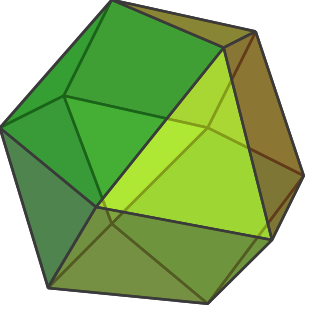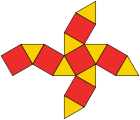
Back مقطوع المكعب الثماني Arabic Кубоктаедър Bulgarian Cubooctàedre Catalan Kuboktaeder German Κυβοκτάεδρο Greek Kubokedro Esperanto Cuboctaedro Spanish Kuboktaedro Basque مکعبهشتوجهی Persian Kuboktaedri Finnish
| Cuboctahedron | |
|---|---|
 (Click here for rotating model) | |
| Type | Archimedean solid Uniform polyhedron |
| Elements | F = 14, E = 24, V = 12 (χ = 2) |
| Faces by sides | 8{3}+6{4} |
| Conway notation | aC aaT |
| Schläfli symbols | r{4,3} or rr{3,3} or |
| t1{4,3} or t0,2{3,3} | |
| Wythoff symbol | 2 | 3 4 3 3 | 2 |
| Coxeter diagram | |
| Symmetry group | Oh, B3, [4,3], (*432), order 48 Td, [3,3], (*332), order 24 |
| Rotation group | O, [4,3]+, (432), order 24 |
| Dihedral angle | |
| References | U07, C19, W11 |
| Properties | Semiregular convex quasiregular |
 Colored faces |
 3.4.3.4 (Vertex figure) |
 Rhombic dodecahedron (dual polyhedron) |
 Net |
A cuboctahedron is a polyhedron with 8 triangular faces and 6 square faces. A cuboctahedron has 12 identical vertices, with 2 triangles and 2 squares meeting at each, and 24 identical edges, each separating a triangle from a square. As such, it is a quasiregular polyhedron, i.e. an Archimedean solid that is not only vertex-transitive but also edge-transitive.[1] It is radially equilateral.
Its dual polyhedron is the rhombic dodecahedron.
The cuboctahedron was probably known to Plato: Heron's Definitiones quotes Archimedes as saying that Plato knew of a solid made of 8 triangles and 6 squares.[2]
- ^ Coxeter 1973, pp. 18–19, §2.3 Quasi-regular polyhedra.
- ^ Heath, Thomas L. (1931), "A manual of Greek mathematics", Nature, 128 (3235), Clarendon: 739–740, Bibcode:1931Natur.128..739T, doi:10.1038/128739a0, S2CID 3994109
© MMXXIII Rich X Search. We shall prevail. All rights reserved. Rich X Search


